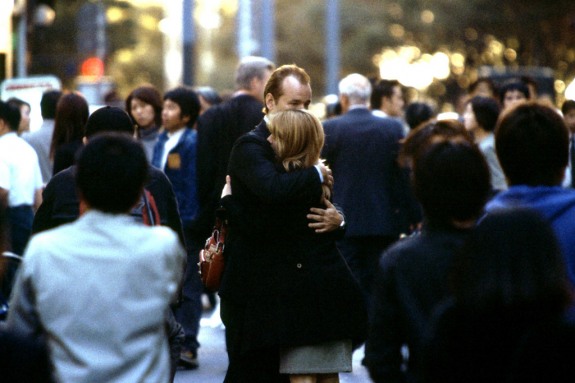
“That’s the way I work: I try to imagine what I would like to see.”
“I’m used to people not expecting much from me.”
– Sofia Coppola, from The New York Times, August 31, 2013
“Don’t let Sofia’s littleness and quietness confuse you. Sofia is made of steel. She’s tough, but she doesn’t pretend to be a man. She has a way of getting her way. She’s very polite about it. She nods her head and says, ‘You’re right, you’re right, but this is what I want to do.’ And it works. When you see her movies, you forget that she is Francis’s daughter. She has been able to reinvent what her last name represents.”
– Bill Murray, from The New York Times, August 31, 2003
“She has succeeded on her own terms and in her quietly confident way, defining some kind of hazy-youth cultural drift, the somnambulance of a generation raised on style, ironic pastiche and disengagement. How long that moment will last is anyone’s guess but, thus far, Sofia Coppola is its most distinctive arbiter.”
– Sean O’Hagan, from The Guardian, October 8, 2006
Sofia Carmina Coppola was born on May 14th, 1971 in New York City, New York, USA, to father Francis Ford Coppola and mother Eleanor Jessie Coppola.
The youngest of three siblings and the only female (her older brothers being the late Gian-Carlo and Roman), Sofia was always her father’s favorite.
With her father being who he is; her mother being a filmmaker, painter and writer; her paternal grandfather, Carmine Coppola, a musician, composer and musical director who wrote music for “Apocalypse Now” as well as for the entire Godfather trilogy and won an Oscar for his work in the second installment of said trilogy (his son’s masterpiece) along with Nino Rota; and her aunt being actress Talia Shire; Coppola grew up and was literally raised in art, filmmaking, and Hollywood.
Among the earliest memories of her life are sitting on Andy Warhol’s lap, and riding in helicopters in the jungle in Philippines, as her father was making “Apocalypse Now”.
As a child, she was also used to people like the aforementioned Warhol, Marlon Brando, Werner Herzog, George Lucas, Martin Scorsese, Steven Spielberg and Woody Allen coming to visit at her house, and sitting at the dinner table with them.
As a teenager, she had to face the passing of her oldest brother in an accident (his daughter, Gia Coppola, is now a filmmaker as well, having made the film “Palo Alto” in 2003) and became friends with Spike Jonze, who would later become her first husband (the couple divorced in 2003).
Coppola graduated from Mills College in the San Francisco Bay Area and the California Institute Of The Arts (CalArts), which was founded by Walt Disney in 1961, and then worked for Karl Lagerfeld and Vogue Paris and did some photographic work. She then also studied painting. Then she, along with Kim Gordon, (yes, the Kim Gordon from Sonic Youth) founded the fashion line MilkFed, which is sold in Japan.
In 1989, the film “New York Stories” was released. It’s an anthology film celebrating New York City, consisting of three short films. The first one, “Life Lessons”, was directed by Martin Scorsese; the second one, “Life Without Zoe”, was directed by her father and written by her, at age 16-17; the third and last one, “Oedipus Wrecks”, was written and directed by Woody Allen.
In 1993, at 22, she directed the video for Walt Mink’s song “Shine”. Five years later, encouraged by her father, she co-wrote and directed the short film “Lick The Star” with the great Peter Bogdanovich himself among the cast. Afterwards, she read the novel “The Virgin Suicides” (1993) by Jeffrey Eugenides and decided to become a filmmaker adapting it as her first feature film.
Coppola has always been a very unique artist in the cinematographic landscape of the United States. All of her films, in one way or another, deal with a lack or absence of connection and communication, sadness, apathy, lack of focus or direction in life, the universal need human beings have for belonging, and the ephemeral nature of youth and beauty and the melancholy it brings.
A true aesthete, her work is always formally and stylistically impeccable. Her camera is exquisitely still many times and when it’s not, its movements are always subtle and swift, her color palettes uniformly beautiful, the use of light never fails to astound, and the characters always emit just what she wants, be it through the excellently written dialogue, their looks, their movements, or their faces.
Pop music is used as a way to help frame the situation or mood of various scenes to perfection. And, of course, the production and costume design of her films are always a delight. All of this makes her one of the greatest and most advanced follower of filmmakers like Antonioni, Scorsese, Visconti and Malick.
We will now proceed to celebrate 10 of the greatest scenes the great and sometimes underestimated and overlooked Sofia Coppola has directed.
The Virgin Suicides (1999)
1. The First And Last Celebration
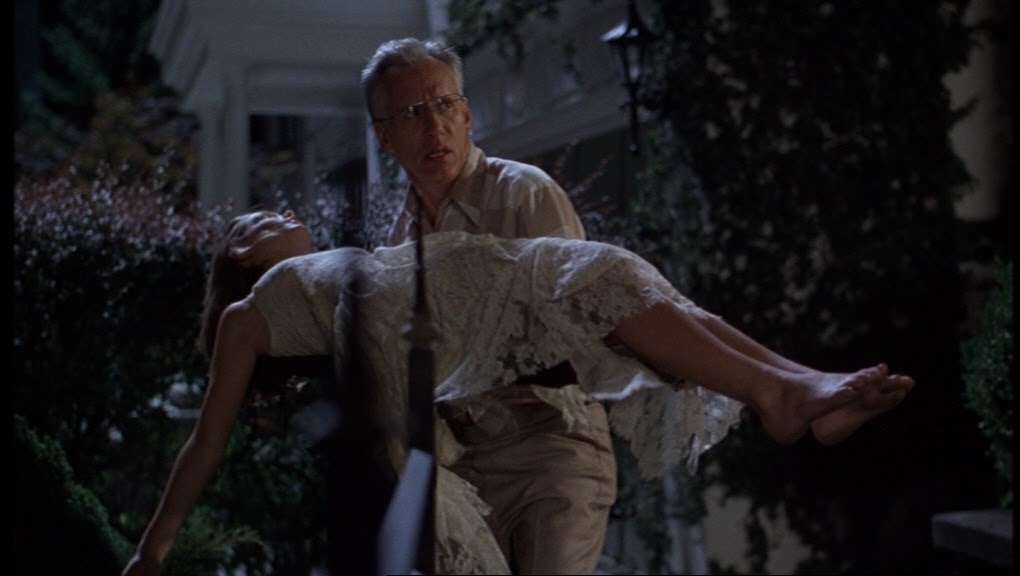
In this film about the Lisbon family, and five teenage Catholic sisters in 1970s Michigan who all commit suicide, we have the pivotal scene of the first and only party the sisters are allowed to throw at their house by their very conservative, old-fashioned, and extremely overprotective Catholic parents.
They agree to such a thing after their youngest, Cecilia, slits her wrists in the bathtub and is rushed to the hospital; the psychiatrist on duty notices the way the girls have been raised, suggesting to the Lisbons that it would be good for her to socialize and mingle with the other sex.
The party is organized and the neighborhood boys receive awkward, outdated invitations in the mail. Since they all have crushes on the Lisbon sisters, they agree to attend. The party is held at the basement, which is decorated with colored balloons, and the girls’ parents are present the whole time.
Both the boys and the girls are awkward and shy, but try their best to socialize under such circumstances. The only one who doesn’t make any effort is Cecilia, remaining sitting the entire time, uttering no words at all. Her sisters gathered all her bracelets and put them over Cecilia’s wrist bandages, securing them with adhesive tape.
The Hollies’ beautiful, poignant, sad and haunting rendition of “The Air That I Breathe” starts playing. Cecilia gets up and asks her mother if she may be excused and starts taking off the bracelets that are making her uncomfortable. Pressured, Mrs. Lisbon reluctantly agrees. Cecilia goes up the stairs without saying goodbye. The song keeps on playing. The boys are starting to get the girls to laugh at their jokes.
Suddenly, a horrible, dreadful, terrifying sound is heard and everybody panics. They all go upstairs and find that Cecilia has jumped from her bedroom window and has landed exactly on the iron fence in the front garden, impaling herself. All look in horror; Mrs. Lisbon starts crying hysterically, trying to prevent the girls from looking at their sister. Mr. Lisbon holds Cecilia’s body, not knowing what to do. The boys run away terrified and the garden sprinklers start working.
Coppola achieves here an unforgettable, terrifying, sad and gloomy detonating scene that, with its absurd, black humor provoked by the garden water sprinkles suddenly starting to work, while Mrs. Lisbon cries and tries in vain to prevent her surviving daughters from seeing Cecilia’s body, and Mr. Lisbon holding the body not knowing what to do; it sets the tone for the rest of the film, with dread, death, humor and the experiences of coming of age all looming all throughout the film.
When the water starts running, Coppola shows the situation from a distance in a long shot, depicting the absurdism of the situation, without getting too involved via the use of close ups or medium shots.
Lost In Translation (2003)
2. More Than Karaoke
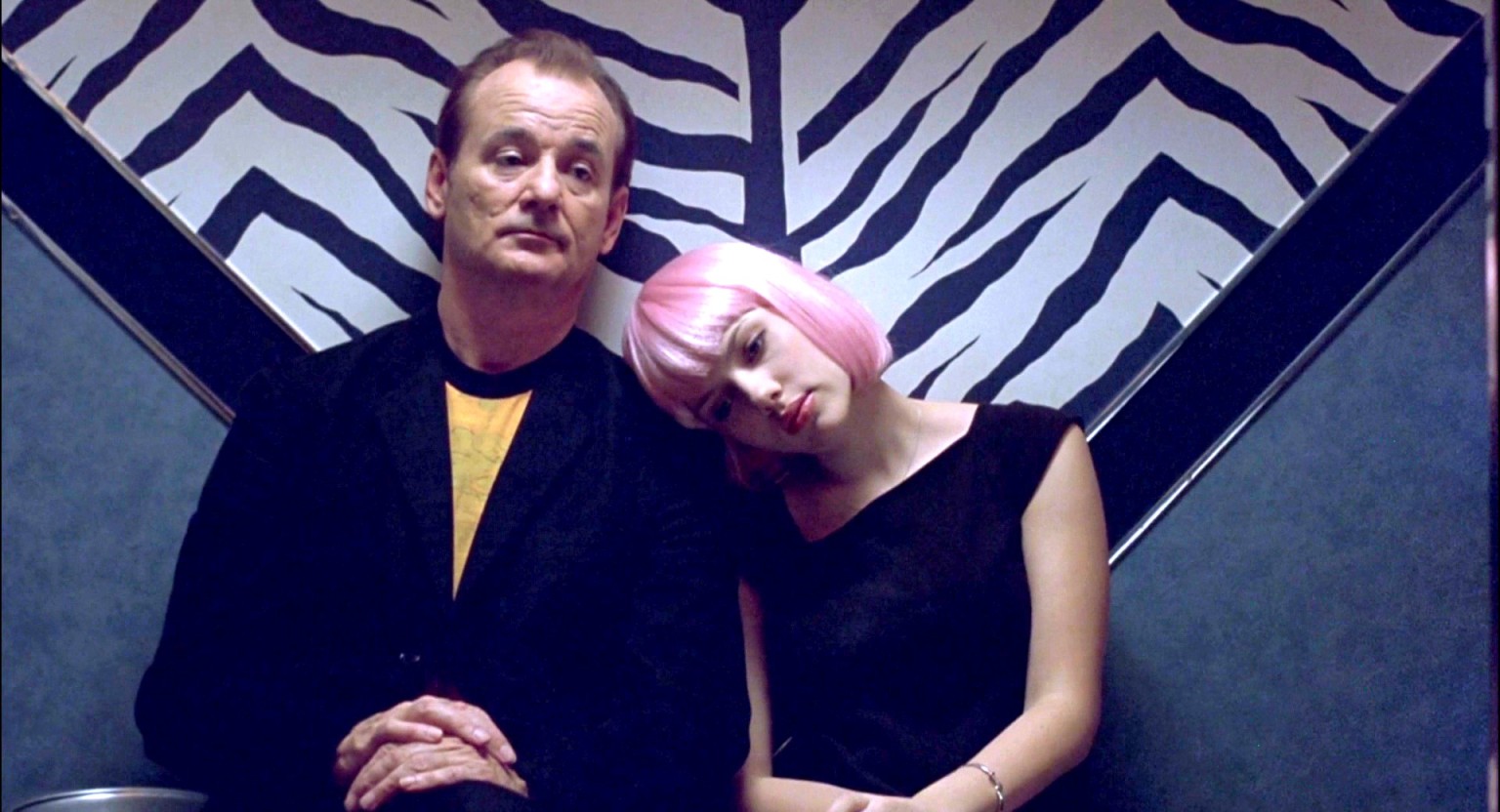
In Coppola’s masterpiece, we witness the deep, special, intimate, moving, unique bond that forms between aging and fading Hollywood actor Bob Harris, and lonely newlywed and Yale philosophy graduate Charlotte, who are both staying at the Tokyo Park Hyatt Hotel.
One day, Charlotte invites Bob for a night out in the city with her and her husband’s Japanese friends, which include a man named Charlie (a real-life friend of Coppola’s).
At the end they all go to a karaoke bar. Charlie sings the Sex Pistols’ classic “God Save The Queen”; Bob does his best with Elvis Costello’s version of “(What’s So Funny ‘Bout) Peace, Love, And Understanding”; and Charlotte sings The Pretenders’ “Brass In Pocket”, looking at Bob all the while as she sings the very evident sensual/sexual innuendos of the song’s lyrics.
Finally, Bob takes the microphone again to sing the great Roxy Music classic “More Than This”, and this time, he’s the one who looks at Charlotte throughout, longingly singing the songs verses: “…It was fun for a while / There was no way of knowing / Like a dream in the night / Who can say where we’re going / No care in the world / Maybe I’m learning…”
Afterwards, we see Charlotte outside the karaoke booth, resting seated on a bench and smoking. Bob gets out and sits next to her. Charlotte, after a moment, leans her head on Bob’s shoulder. It’s the perfect way to portray the growing bond between Bob and Charlotte.
A bond growing in trust, intimacy, strength and intensity, while at the same time, remaining almost completely unspoken, tacit, relying on subtle movements, looks and facial expressions to show the love between our two main characters. This scene could also be considered to have been adapted from a very similar scene from the great Aki Kaurismäki masterpiece, “Take Care Of Your Scarf, Tatiana”.
3. Bed Haven
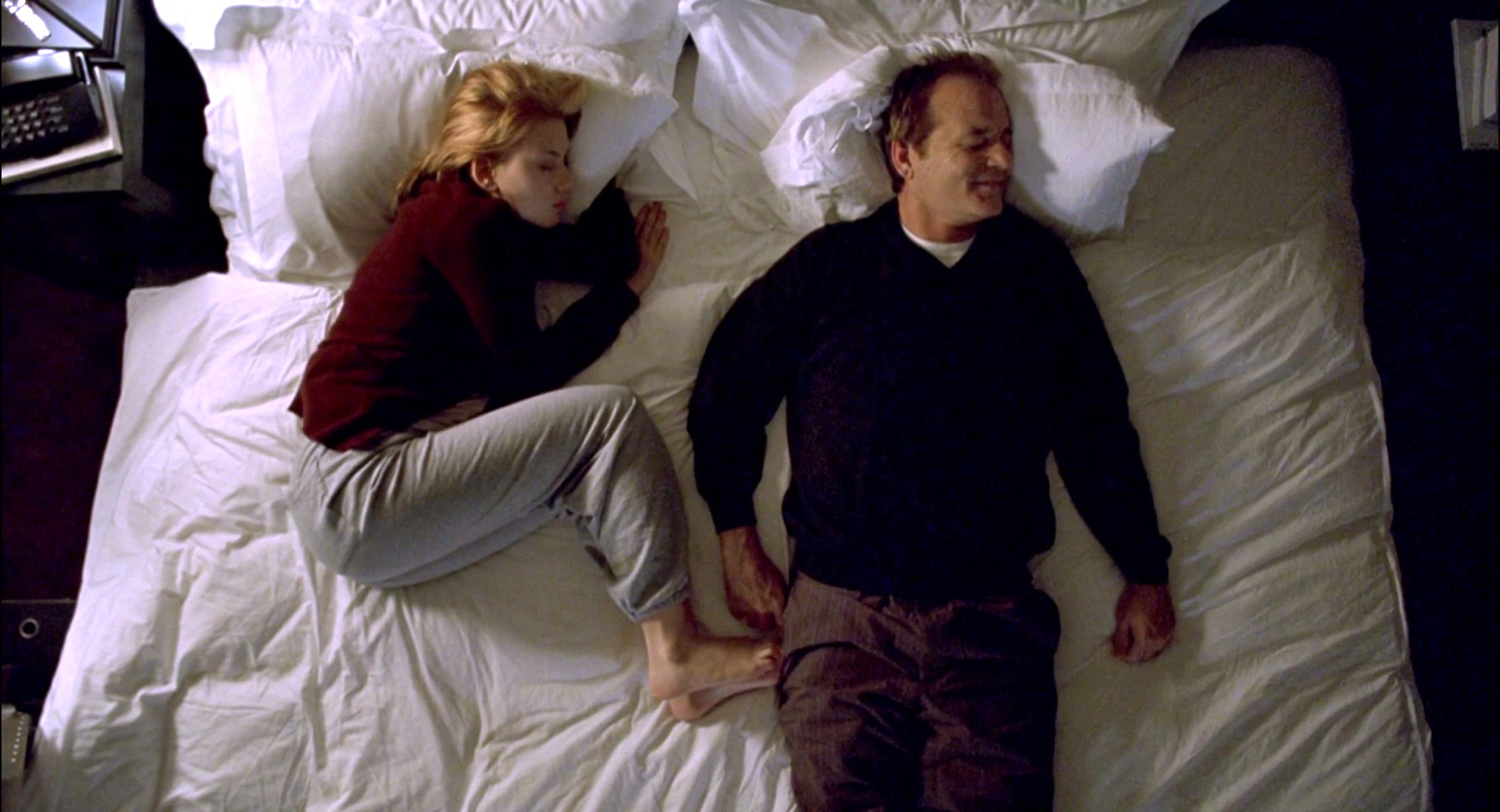
Later in the movie, very late at night, both insomniacs are wide awake. Bob sends a message to Charlotte’s room asking if she’s awake. We then see them in Bob’s room watching Fellini’s “La Dolce Vita” (1960), with Bob laying on his bed and Charlotte sitting on the floor as they drink sake. Then both sit on the bed and Charlotte says, “Let’s never come here again, cause it’d never be as much fun.”
Afterwards, they lie on the bed over the covers, talking and sharing some of their most intimate thoughts, insecurities, fears, pains and regrets. Bob tenderly grabs Charlotte’s bare feet and tells her he’s sure she will turn out to be a great and very successful person. They fall asleep.
A silently, understatedly climatic scene where the bond between Bob and Charlotte reaches its pinnacle. A scene incredibly moving and real, where the characters lay completely bare their innermost feelings and their very selves, without tears, screams, much movement at all or sex. The very essence of the film and Coppola’s oeuvre.
4. Just Like Honey
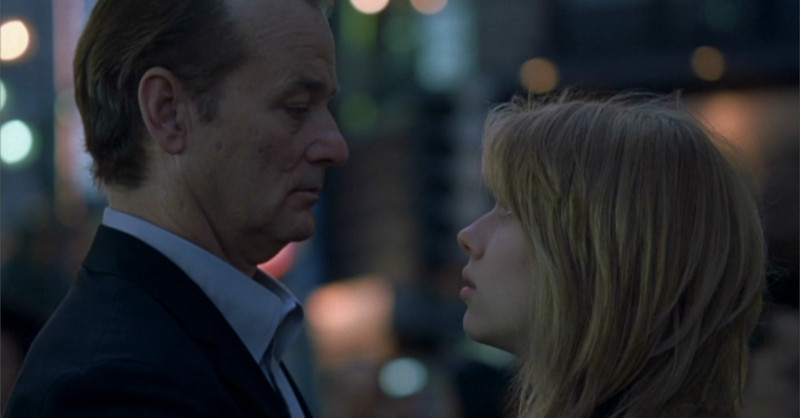
Finally, it’s the turn of what is perhaps one of the greatest and most famous, talked about, discussed, analyzed and dissected endings in cinema history. The day arrives when Bob must leave Tokyo to go back to his children and loveless marriage in Los Angeles.
When the car taking him to airport is about to arrive, Bob is in the lobby and calls Charlotte in her room. She’s not there, however. He leaves a message saying he forgot a jacket in her room and that he’s leaving, so he’ll leave the jacket with her.
After he hangs up, Charlotte comes out of an elevator with Bob’s jacket and they just look at each other without saying a word, and it feels as if they could both start crying at any moment and Charlotte says “goodbye” and leaves, entering an elevator.
Bob leaves and on his way to the airport, he sees Charlotte walking down a very busy street. He gets out of the car and follows her, calling for her to stop. She turns to look at him, with tears in her eyes. They embrace. Bob whispers something in Charlotte’s ear, something inaudible to the audience.
They kiss, as The Jesus And Mary Chain’s magnificent anthem “Just Likes Honey” begins playing, and then they let go. They wave good bye. Bob goes back to the car and Charlotte keeps on walking, and as she reaches the bottom of the screen we can see her beginning to smile very slightly.
We follow Bob’s car down Tokyo’s highways with “Just Like Honey” still playing. The end. Not much can be said about this ending. It’s up to each viewer to make up their mind and let the magic of the film capture them.